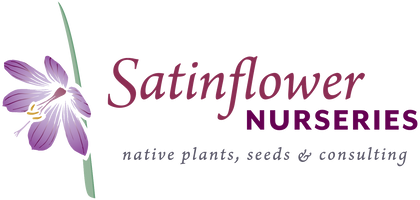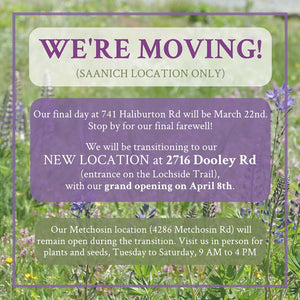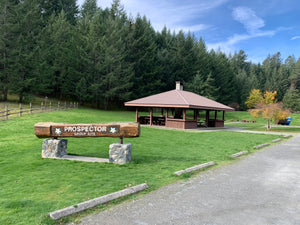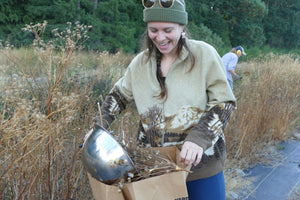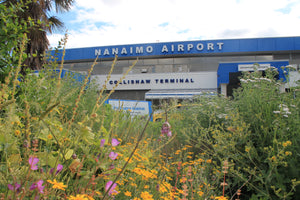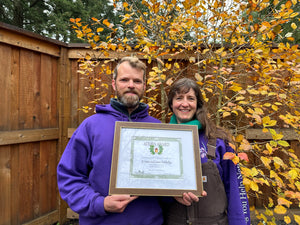The Weekly with Daly: Pollinator Steward Certification

The Weekly with Daly is a regular column about the musings of the nursery and nature written by our in-house wildlife observer and passionate conservationist, Julia Daly.
The Weekly with Daly: Pollinator Steward Certification
September 25, 2021
Working amongst the native plants at Satinflower Nurseries, I am ever distracted by the the diversity of pollinators working alongside me. Bumblebees, mason bees, leafcutting bees, carpenter bees, long-horned bees, yellow-faced bees, flies, wasps, butterflies, moths, beetles, ants, hummingbirds and more, are all here pollinating flowers of every shape and colour. I am learning to recognize a select few of them by species—pollinator watching is going to be a lifelong pursuit. BC has the highest bee diversity in Canada, with over 480 species; of these 17% are endangered.
Pollinators provide a tremendous ecosystem service. They are needed by over 90% of Earth’s flowering plants to reproduce and pollinate countless food plants for humans and wildlife. Alarmingly many pollinator populations—including native pollinators—are in decline. Loss and degradation of feeding and nesting habitats appear to be driving these declines, though pesticide exposure, disease and climate change are also contributing.
The more I learn about pollinators, the more I want to find ways of supporting them, so when Pollinator Partnership Canada launched the *Pollinator Steward Certification program in the spring of 2020 I was quick to come aboard. Certification is a two-part process that requires 1) completing a minimum of 10 hours of training on pollinator ecology and conservation, and 2) showing your commitment to pollinators by conducting at least one ‘habitat action’ and one ‘outreach action’ of your choice, to be completed within one year of the training workshops. See the Island Pollinator Initiative website to learn more about this informative and inspiring program and how to register https://pollinatorpartnership.ca/en/pollinator-steward-webinar-series
One of the most important things we can do to support pollinators is preserving and creating pollinator habitats using a diversity of native plants. Even small-scale habitat creation makes a difference (figure 1). I’ll leave you with some photos of the pollinator meadow I created at home with my 4 and 6-year-old daughters last year, plus a sample of the beauty of pollinators on Southern Vancouver Island.

Figure 1. Native planters for pollinators
Signing off,
Julia

* The Pollinator Steward Certification program is brought to you by Pollinator Partnership Canada. Webinars affiliated with this program were done in partnership with Habitat Acquisition Trust, Satinflower Nurseries, and Parks Canada. Webinar Series (islandpollinatorinitiative.ca)
Photos of my family’s (first) pollinator meadow
 Figure 2
Figure 2
 Figure 3
Figure 3
Figures 2 and 3. Seedlings emerging from the soil in early March 2021; the meadow’s first spring! The area used to be a barren patch of grass. The previous summer we used cardboard, grass clippings and leaf mulch to smother the turf, then seeded it with a native wildflower blend in October 2020.
 Figure 4
Figure 4
Figure 4. This photo was taken in March 2021, after being seeded in October 2020. Sea blush (Plectritis congesta), sticky cinquefoil (Drymocallis glandulosa), western buttercup (Ranunculus occidentalis), farewell-to-spring (Clarkia amoena), small-flowered blue-eyed-mary (Collinsia parviflora) and pacific woodrush (Luzula comosa) are seen here. Consider leaving some bare patches of soil as a habitat element for ground-nesting pollinators.

Figure 5. My daughter Fiona, age 4, finds a quiet spot to think.
 Figure 6
Figure 6
 Figure 7
Figure 7
Figure 6 and 7. The meadow transforms into an explosion of Clarkia amoena in June.
 Figure 8
Figure 8
Figure 8. My daughter Ramona, age 6, in mid-September 2021, preparing to add some additional species to the pollinator meadow with a seed blend that includes native mustards designed to attract Julia’s orangetip butterflies (Anthocharis julia flora). She is using sand as a ‘carrier’ to disperse seeds evenly over the meadow.
----------------------------------
VI pollinators through the seasons
Late winter

Figure 9.
Figure 9. Mourning cloak (Nymphalis antiopa). Unlike most butterflies, this species hibernates for winter as an adult, finding refuge in bark, tree cavities, or woodpiles. The one seen here has recently emerged from winter hibernation. Many butterfly species nectar on a variety of plants, but only lay their eggs on a select few. The caterpillars of mourning cloaks prefer the leaves of willows, black cottonwood and trembling aspen.
Spring
 Figure 10
Figure 10
 Figure 11
Figure 11
Figure 10. Painted lady (Vanessa cardui) sunning itself on a warm rock. This species uses a variety of larval food plants including woolly sunflower, lupines, pearly everlasting and native thistles
Figure 11. Mating cabbage whites (Pieris rapae) on red alder leaves. The cabbage white is a common invasive butterfly on Vancouver Island, preferring to lay its eggs on members of the mustard family, including many agricultural crops, like broccoli, cauliflower and cabbage.
Summer
 Figure 12
Figure 12
 Figure 13
Figure 13
Figure 12. Western leafcutter bee (Megachile perihirta) nectaring on and pollinating mountain sneezeweed (Helenium autumnale var. grandiflorum)
Figure 13. Woodland skipper (Ochlodes sylvanoides) nectaring on and pollinating pearly everlasting (Anaphalis margaritacea)
Fall

Figure 14.
Figure 14. Narrow-headed marsh fly (Helophilus fasciatus) nectaring on and pollinating a late bloom of Douglas’ aster (Symphyotrichum subspicatum)
- Satinflower Nurseries
